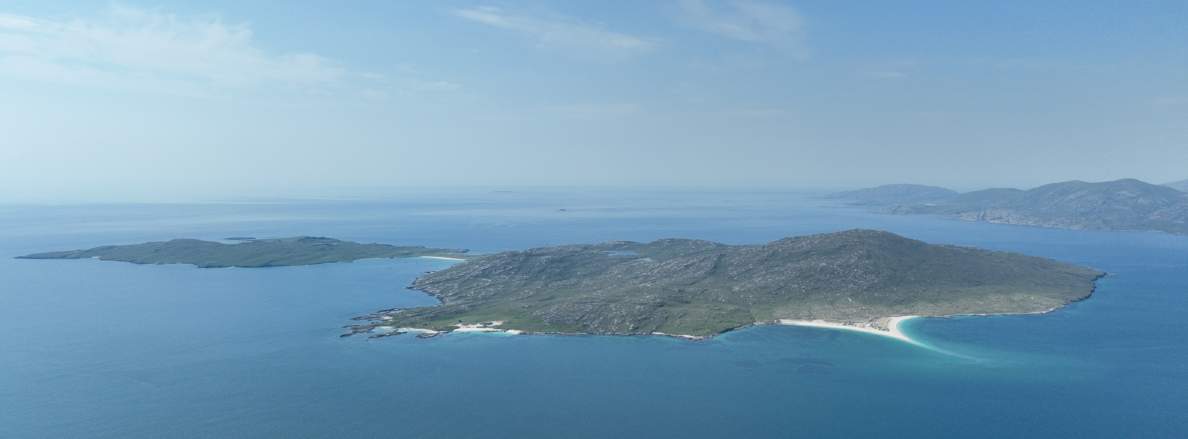The first step has been to carry out an audit of the island’s many ecological and social regeneration opportunities, capturing these in a prospectus for interested parties. These opportunities include supporting and enhancing a variety of habitats and wildlife; drawing down atmospheric carbon; attracting sustainable tourism; and providing a once-in-a-life-time opportunity to deploy ecological restoration on a UK island with distinct biogeography, whilst being mindful of the social and historic context.
Adam and Cathra Kelliher purchased Taransay in June 2011, attracted by the breathtaking, raw beauty of the island but also by the potential for long-term ecological and historical restoration. The Kellihers have achieved a lot in the intervening period including the reduction of sheep and introduction of cattle thus re-establishing more balanced grazing, and the employment of experts to advise on the island’s ecology, wildlife and the planting of native trees. They have also delved into the early stages of an ecotourism venture with the introduction of highly popular day trips to the island.
However, in this era of climate crisis and environmental degradation, they justifiably feel that now is the right time to create a model of collaboration involving land ownership and third-party involvement. This will involve pooling resources to develop a genuinely unique nature restoration project whilst ensuring social inclusion, and celebration of the island’s geological, archaeological, historical and cultural heritage.
Taransay measures around 1,395 hectares and encompasses 21.5 miles of spectacularly varied coastline. It effectively comprises two separate islands which are dramatically joined by an isthmus lined, on either side, by fine white sand beaches. From the gentle curve of its many beaches to the cliffs that provide nesting places for eagles, Taransay is an island of contrasts including a natural archway over the sea on the Atlantic side, made of rock formed around 2.5 billion years ago. From its high peaks, awe-inspiring vistas unfold: the Uist island chain falling away to the south, the spectacular Luskentyre Estuary directly east, the Flannan Isles out to the north-west and the distinctive and mysterious outline of St Kilda far out in the Atlantic to the west.
Taransay evokes a sense of timelessness and mystery and there is no doubt that its sheer vastness and raw beauty touches everyone who visits. However, it also presents a unique opportunity to carry forward a cutting edge, exemplar restoration project in splendid isolation.
1. HISTORY OF THE ISLAND
It is believed that Taransay was inhabited thousands of years ago. Around 300AD there were three villages - Uidh, Raa and Paible, the latter being the largest settlement on the island. The Vikings took over in 900AD following their invasion of Scotland, with evidence that this is where the name Taransay derived from, being an Old Norse translation of ‘the Isle of Taran’. Whilst the last inhabitants of Taransay left in 1974, their historical remnants and presence are prevalent across the island, from the remains of their black houses above the beach at Paible to the ruins of the Iron Age crannog in the middle of the uppermost loch. There is a standing stone, sporting a mysterious swirl, above the beach at Uidh, as well the mound of an old doune, as yet unexcavated, near Paible. There are many local stories of adventure and intrigue as well as of battles.
2. NATURE RESTORATION
Taransay plays host to a charismatic range of species including wading birds, sea birds, a colony of seals, dolphins, whales and basking sharks: it is a rare day on the island when you do not catch sight of either a golden eagle or a sea eagle hanging on a thermal. The island is home to iconic and rare machair grassland as well as coastal dunes, sea cliffs, grassland, peatland and heath.
However, despite the remote nature of the island, few parts of Taransay have been unimpacted by human intervention in the past. Decades of overgrazing by sheep and deer have led to a loss in the variety of habitats and species which would once have thrived there. Coastal Atlantic rainforest or scrub is no longer present. However, the peatland soils which cover a significant part of the island are in good condition and are a notable carbon sink whilst also being the base for wider biodiversity. There is an exciting opportunity to demonstrate nature restoration alongside social involvement and an innovative partnership.
3. COMMUNITY INCLUSION
It is evident from historical and archaeological records that Taransay and the wider Harris communities were at the heart of the island. Communicating the human history on Taransay is important in order to acknowledge the past, whilst providing the opportunity to connect with the current communities and allow the continuation of the link between Taransay and the Outer Hebrides. The Kellihers have initiated community connections by providing regular boat trips to the island. There is wide scope to enhance this, for example by establishing educational programmes and encouraging volunteers - from local communities, schools, colleges and universities, and the provision of jobs in the rebuilding of some of the island’s black houses and various aspects of tourism and wildlife restoration.
4. ECO-TOURISM
Increasing awareness of environmental issues has resulted in changes in consumer behaviour with new travel attitudes favouring eco-tourism opportunities. The owners have welcomed responsible tourists over the years and the island, with its striking geology and rich heritage, offers great potential to extend this. A model for responsible travel and tourism could be developed on Taransay which may provide additional revenue sources. This might involve creating a programme of ecological and archaeological restoration activities, or sensitively developing wild spa and digital detox enterprises.


.jpg)
.jpg)
.jpg)





